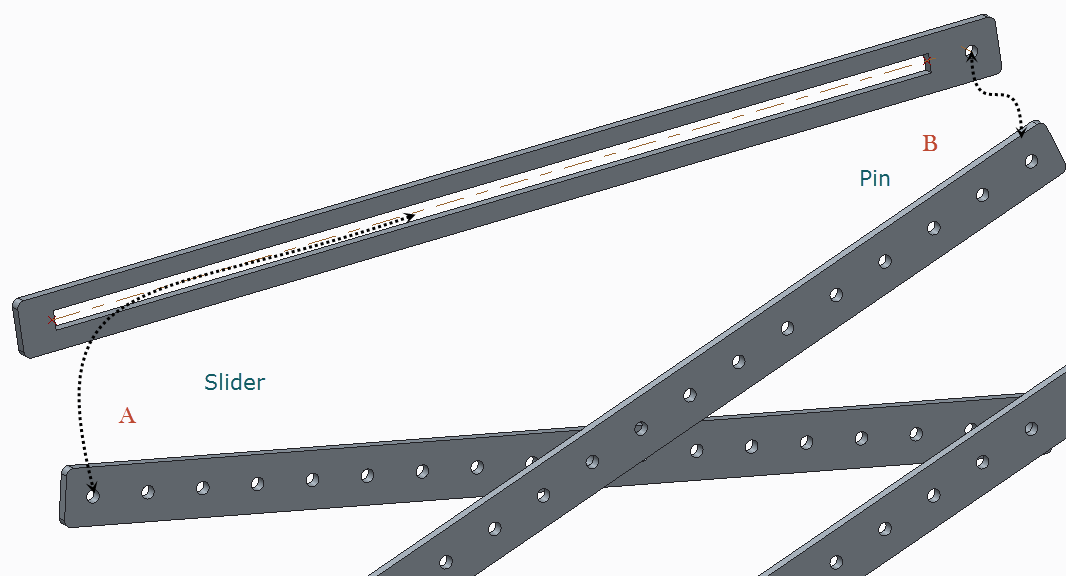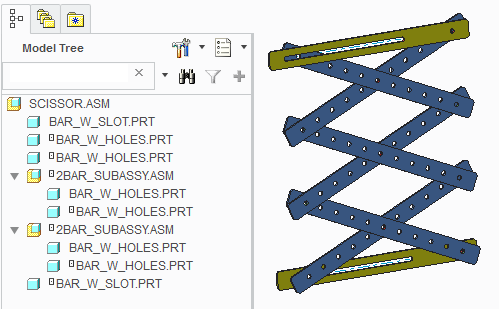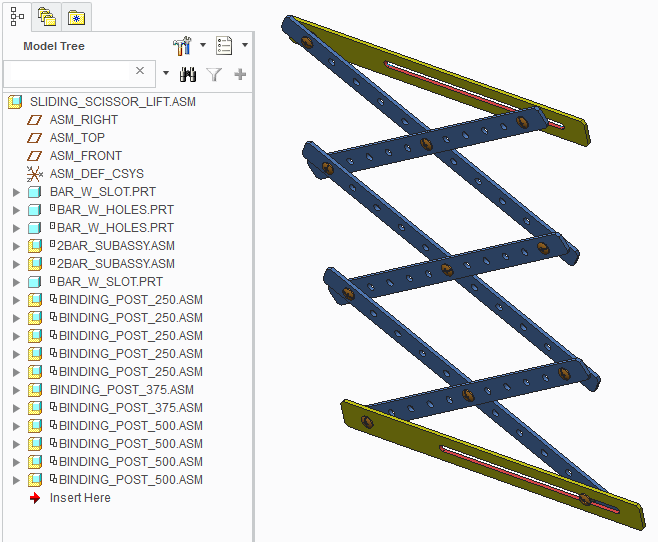Community Tip - You can subscribe to a forum, label or individual post and receive email notifications when someone posts a new topic or reply. Learn more! X
- Community
- PTC Education
- PTC Education Forum
- Re: Scissor and Slot/Slider Mechanism Combo
- Subscribe to RSS Feed
- Mark Topic as New
- Mark Topic as Read
- Float this Topic for Current User
- Bookmark
- Subscribe
- Mute
- Printer Friendly Page
Scissor and Slot/Slider Mechanism Combo
- Mark as New
- Bookmark
- Subscribe
- Mute
- Subscribe to RSS Feed
- Permalink
- Notify Moderator
Scissor and Slot/Slider Mechanism Combo
Pictured is the top part of our scissor mechanism. There's a Pin constraint at every joint where the beams intersect. They work fine and 'scissor' as expected.
Now I want to attach the beam with the slot and hole in in such that it's Pinned to one scissor beam (at B) and a peg in the other beam (A) slides through the slot as the scissors expand/contract.
I've been at this for a while and just can't get it - usually I can't get past 'connection definition is incomplete' sort of messages. If I do get past that it just doesn't do much of anything.
I've tried Slot and Slider constraints on A using the hole on the scissor beam and putting an axel through it and using that.
I've defined an axis and planes but they're not taken as valid selections while defining the constraints. This makes me wonder if I'm just doing something fundamentally wrong - I'm not a mechanical engineer type.
Thanks,
Dan Holt
FTC 7300 Mentor

Solved! Go to Solution.
- Tags:
- mechanism
Accepted Solutions
- Mark as New
- Bookmark
- Subscribe
- Mute
- Subscribe to RSS Feed
- Permalink
- Notify Moderator
Dan,
You were pretty close. I only adjusted three things.
- Created a Sketched Curve in the slot model intead of point-point.
(not sure if that was required, but wanted to rule it out) - Created an offset point in the arm model to align with the sketched curve in the slot model.
- Changed the assembly units to MM

It moves a little funky becuase the first component is placed as a Default, locking it into position. In my example, I used the slot model as the first component and then added the cross members to it. That kept the lifting cross linked into the slot model. Hope this helps ![]()
- Mark as New
- Bookmark
- Subscribe
- Mute
- Subscribe to RSS Feed
- Permalink
- Notify Moderator
Dan, if you want to send me the models, I can take a look at it. If you ZIP it up and put it in the CAD folder of your Windchill project, I could pick it up from there. Sounds like you are pretty close. To use the Slot connection, you'll need a datum curve and a datum point. I would suggest putting a datum curve down the center of your slot. Then create a datum point at the center of A, but offset enough to be coincident with the curve when assembled (or on the mating surfaces).
- Mark as New
- Bookmark
- Subscribe
- Mute
- Subscribe to RSS Feed
- Permalink
- Notify Moderator
Dan, I was able to create something similar this morning. Not sure if its exactly the same, but should be in the ball park. I have uploaded the models as a new document if you want to download and check them out.

- Mark as New
- Bookmark
- Subscribe
- Mute
- Subscribe to RSS Feed
- Permalink
- Notify Moderator
Patriots are not playing till 8:00pm tonight and its really cold out today. So, I added some hardware and made it a lttle more realistic. I'm not a scissor lift specialist by any meams, but this is much better than the first model. I tend to skip all the required hardware and fasteners for the initial concept and then find they drive the final design once you have them all in there.
I decided to go with a binding post as a connection simply becuase it was the smallest form factor. I found them also referred to as screw posts, barrel nuts, sleeve nuts and connector nuts. I'm assuming if you buy these in stainless they would be rugged enough for this type of scissor lift, but have never built this for real. Curious to hear how other teams have constructed these in the past?
The download referenced previously has been updated with the new model.

- Mark as New
- Bookmark
- Subscribe
- Mute
- Subscribe to RSS Feed
- Permalink
- Notify Moderator
Thanks, Scott - that's a lot of help.
I still can't get mine to work, but I'm pretty sure I know why:
* I've got my slotted-bar part included in the assembly - and the curve (no longer an axis) is defined in the part
* But I'm referencing the bars from the tetrix parts in my working directory in my assembly.
* So when I create a point datum for the slot constraint, I'm trying to define it on the included part - from within the assembly.
... which sounds like the wrong thing to do.
So, (maybe tomorrow) I'll try copying and modifying a local copy of the Tertix part and defining the datum point for the slot in there.
I see the Replace option in the model tree - hopefully that will keep me from having to rebuild the scissors. But I'm getting pretty fast at it by now!
Thanks again,
Dan
- Mark as New
- Bookmark
- Subscribe
- Mute
- Subscribe to RSS Feed
- Permalink
- Notify Moderator
Hi Scott. I've tried and tried to get my scissor mechanism to work but can't get past a Assembly Failed To Connect error.
Here are the parts and assemblies I'm using. I've tried to follow your example as closely as possible.
* I copied and modified the supplied tetrix model to define Point Datums for the Slot mechanism
* I created a slotted part based on the dimensions of the Tetrix part
If you get a chance to look at it and tell me what I'm doing wrong I would greatly appreciate it!
Thanks,
Dan Holt
- Mark as New
- Bookmark
- Subscribe
- Mute
- Subscribe to RSS Feed
- Permalink
- Notify Moderator
Dan,
You were pretty close. I only adjusted three things.
- Created a Sketched Curve in the slot model intead of point-point.
(not sure if that was required, but wanted to rule it out) - Created an offset point in the arm model to align with the sketched curve in the slot model.
- Changed the assembly units to MM

It moves a little funky becuase the first component is placed as a Default, locking it into position. In my example, I used the slot model as the first component and then added the cross members to it. That kept the lifting cross linked into the slot model. Hope this helps ![]()
- Mark as New
- Bookmark
- Subscribe
- Mute
- Subscribe to RSS Feed
- Permalink
- Notify Moderator
Sorry - can you tell me what you mean by "Created a Sketched Curve in the slot model intead of point-point."
The curve I added for the slot was a Curve Datum. I should go into Sketch on the surface of the slotted bar piece and ... sketch a Line? I don't see a Curve. Spline?
And ... "Created an offset point in the arm model to align with the sketched curve in the slot model."
The 'arm model' being tetrix_739070_2012_slot_pts.prt? Or is that ab7300scissorarmpair.asm? Either way, does that mean the 4 datum points I added to tetrix_739070_2012_slot_pts.prt are unnecessary?
- Mark as New
- Bookmark
- Subscribe
- Mute
- Subscribe to RSS Feed
- Permalink
- Notify Moderator
Sure,
The curve you created was a point-to-point datum curve. Since it is flat, planar curve, I created it as a Sketch instead. I put a datum plane down the middle of the slot arm and used the datum points as references. Then just sketched a line from point to point.
A Sketch is a curve. You can use it as the path for the slot constraint in Mechanism.
The datum points you added are at the center of the hole and coplanar with the side surfaces of tetrix_739070_2012_slot_pts.prt. I created a new point at the center of the hole, but offset from the side surface by 1.5x the thickness of your model (3.2mm) to line up with the Sketch located at the center of the slot arm. Since the parts are assembled side-by-side, there is a gap of one arm thickness. SInce the sketch is located in the center of the slot arm, I added another 1/2 thickness.
Suppose we could have just put the sketch on the side surface and not had to worry about the 1/2 thickness...
When creating the slot connection, the curve and the point need to be coincident. There cannot be a gap between the point and the curve or you'll get the connection error. In your original model, the first pin joint worked fine. You just needed to add the slot connection with a sketch/point combination. Since there was a 1.5x thickness difference, the point could not line up with the Sketch.
You can see the new point in the screen shot above. It is the one on the right.




